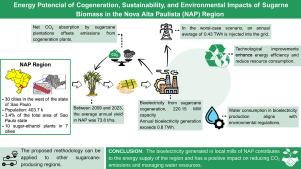新阿尔塔保利斯塔地区甘蔗生物质热电联产的能源潜力、可持续性和环境影响
IF 7
2区 工程技术
Q1 ENERGY & FUELS
Sustainable Energy Technologies and Assessments
Pub Date : 2025-09-29
DOI:10.1016/j.seta.2025.104606
引用次数: 0
摘要
本研究评估了新阿尔塔保利斯塔地区甘蔗生物质发电的潜力,重点是能源和环境可持续性。该方法基于对二手数据的分析,以估计2009年至2023年间该地区工厂的发电量、碳固存、二氧化碳排放和水资源消耗。结果表明,这些工厂产生的生物电对当地能源矩阵贡献显著,平均年潜力超过0.8太瓦时。对不同情景的分析表明,甘蔗种植园的二氧化碳净吸收量超过了工厂的排放量,从而加强了糖能源部门在减缓气候变化方面的作用。此外,工业过程中估计的用水量符合当前的环境指导方针,根据每个工厂的效率而变化。该研究强调了工厂现代化和采用最大限度提高能源效率同时减少水消耗的技术的重要性。根据可靠的国家数据来源,所开发的方法证明可用于本文章由计算机程序翻译,如有差异,请以英文原文为准。

Energy potential of cogeneration, sustainability, and environmental impacts of sugarcane biomass in the Nova Alta Paulista region
This study evaluates the potential for electricity generation from sugarcane biomass in the Nova Alta Paulista region, focusing on energy and environmental sustainability. The methodology is based on the analysis of secondary data to estimate electricity production, carbon sequestration, CO2 emissions, and water resource consumption in the mills of the region between 2009 and 2023. The results indicate that the bioelectricity generated by these mills contributes significantly to the local energy matrix, with an average annual potential exceeding 0.8 TWh. Analysis of different scenarios reveals that net CO2 absorption by sugarcane plantations surpasses the emissions from the mills, reinforcing the role of the sugar–energy sector in mitigating climate change. Additionally, the estimated water consumption in industrial processes aligns with current environmental guidelines, varying according to the efficiency of each mill. The study highlights the importance of modernizing the mills and adopting technologies that maximize energy efficiency while minimizing water consumption. The developed methodology proves to be replicable for other regions of São Paulo and Brazil, relying on reliable national data sources. Thus, the cogeneration of electricity from sugarcane biomass is established as a sustainable solution for energy security and environmental sustainability in the Nova Alta Paulista region.
求助全文
通过发布文献求助,成功后即可免费获取论文全文。
去求助
来源期刊

Sustainable Energy Technologies and Assessments
Energy-Renewable Energy, Sustainability and the Environment
CiteScore
12.70
自引率
12.50%
发文量
1091
期刊介绍:
Encouraging a transition to a sustainable energy future is imperative for our world. Technologies that enable this shift in various sectors like transportation, heating, and power systems are of utmost importance. Sustainable Energy Technologies and Assessments welcomes papers focusing on a range of aspects and levels of technological advancements in energy generation and utilization. The aim is to reduce the negative environmental impact associated with energy production and consumption, spanning from laboratory experiments to real-world applications in the commercial sector.
 求助内容:
求助内容: 应助结果提醒方式:
应助结果提醒方式:


